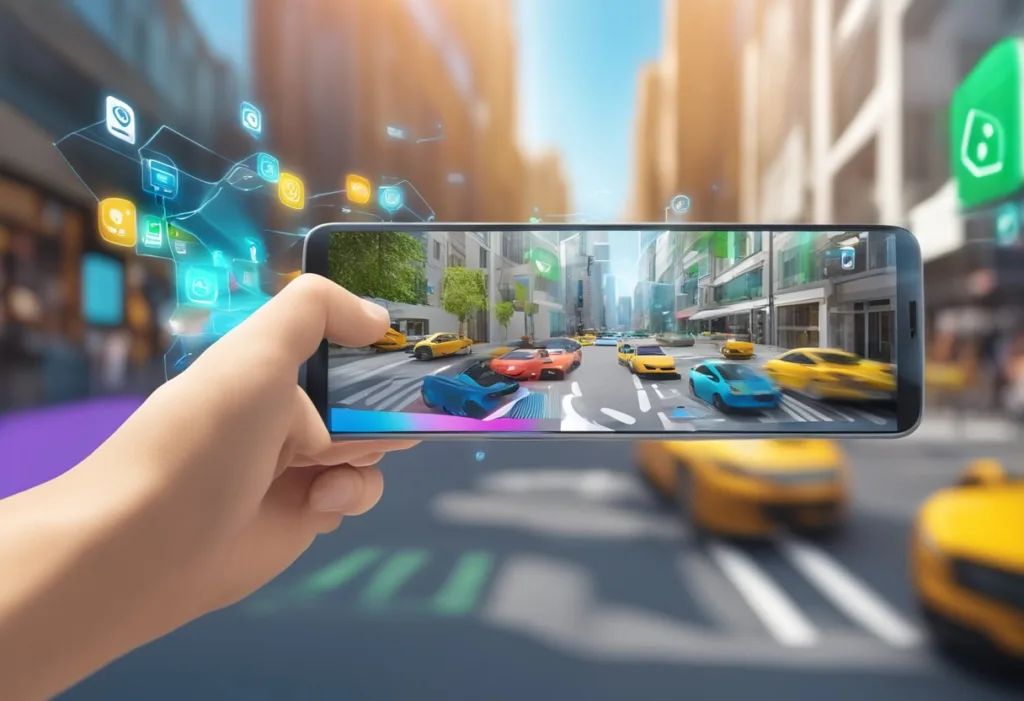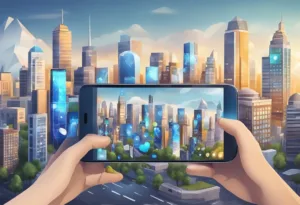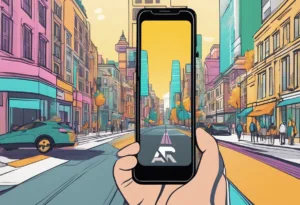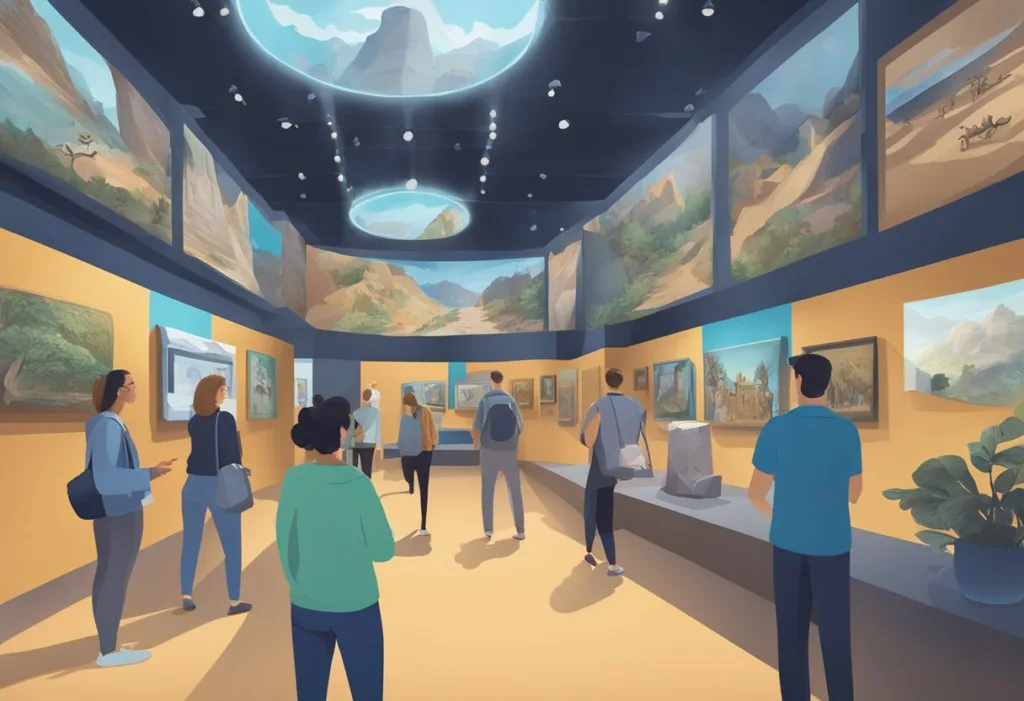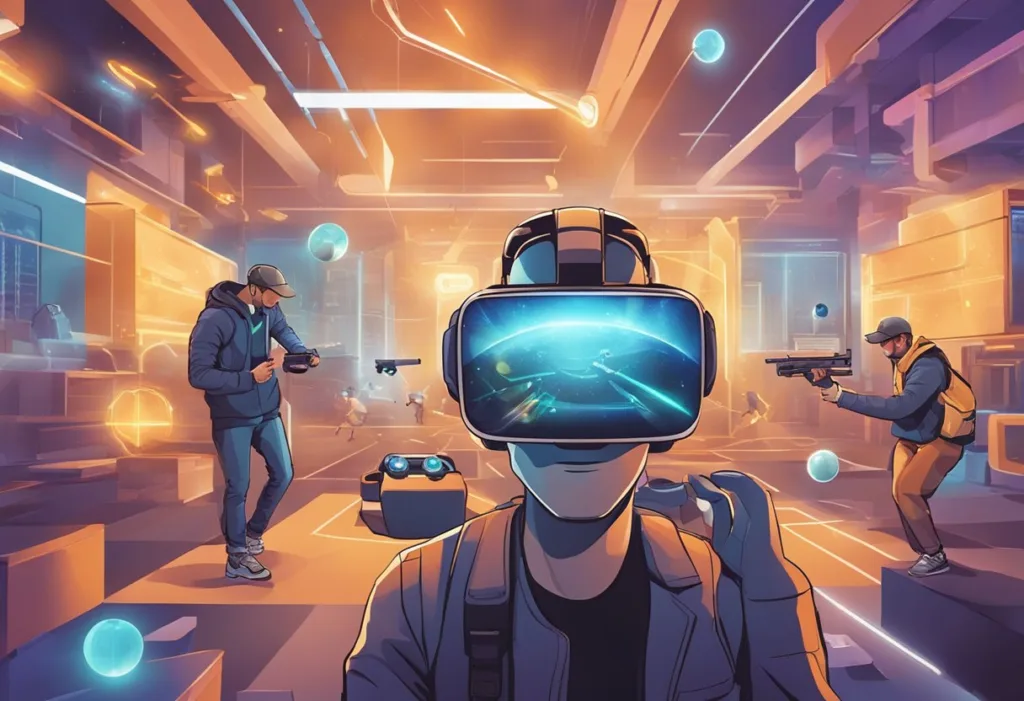Augmented reality (AR) is transforming the way businesses operate, interact with customers, and train their employees. AR technology enhances the physical world by overlaying digital information or graphics onto it, creating an immersive and interactive experience. From retail to healthcare, AR is revolutionizing the way businesses operate, and its impact is only expected to grow. In this blog post, I will share with you 10 augmented reality business examples and how each of these AR business examples work.
In retail, AR is used to enhance the in-store experience by providing customers with interactive product information, virtual try-ons, and personalized recommendations. AR is also used in marketing and advertising to create engaging and interactive campaigns that capture customers‘ attention. In industrial settings, AR is used to improve worker safety and productivity by providing real-time information and guidance. In education and training, AR is used to create immersive and interactive learning experiences that improve engagement and retention.
What is Augmented reality business
Augmented reality (AR) is a technology that superimposes digital information onto the real world, allowing users to interact with digital objects in a physical space. In retail, AR technology has revolutionized the way customers shop and interact with products. By using AR, customers can have a more immersive and personalized shopping experience, making it easier for them to make informed buying decisions.
How Augmented reality business work
AR works by utilizing a smartphone or tablet’s camera to scan a physical object, such as a piece of clothing or furniture. The AR app then superimposes a virtual version of the object onto the screen, allowing the user to interact with it in real-time. This technology allows customers to see how products would look and fit in their home, which can be especially useful for online shopping.
One of the most popular examples of AR in retail is the IKEA AR app, which allows customers to virtually place furniture in their home before purchasing. This app allows customers to see how the furniture would look in their space, helping them make informed purchasing decisions. Other brands have also started to incorporate AR into their online shopping experience, allowing customers to virtually try on clothes and see how they would look in different colors, sizes, and styles.
AR technology has also allowed retailers to personalize the shopping experience for customers. By utilizing AR, retailers can create virtual try-on experiences, allowing customers to see how products would look on them before purchasing. This technology has been especially useful for the beauty industry, where customers can use AR to try on makeup and see how it would look on their skin tone.
AR technology has had a significant impact on the retail industry, allowing customers to have a more immersive and personalized shopping experience. By incorporating AR into their online shopping experience, retailers can improve customer satisfaction and increase sales.
10 Augmented Reality Business Examples
Here are 10 augmented reality business examples:
- Remote Expert Assistance
- Virtual Prototyping
- AR in Retail Shopping
- AR in Training and Education
- Interactive Marketing and Advertising
- AR for Design and Visualization
- AR in Healthcare
- AR in Field Service Management
- AR in Tourism and Travel
- AR in Real Estate
Remote Expert Assistance
Companies like Microsoft and Bosch are utilizing augmented reality to provide remote expert assistance. Microsoft’s HoloLens enables technicians to receive guidance from experts who can see what they see and provide real-time assistance, annotations, and instructions. Similarly, Bosch’s Common Augmented Reality Platform (CAP) allows for remote troubleshooting and maintenance, helping technicians repair and maintain complex machinery with AR overlays that show step-by-step procedures. This technology reduces downtime, travel costs, and accelerates knowledge transfer across industries.
Virtual Prototyping
Automotive giants such as Ford and Audi are leveraging AR for virtual prototyping, which allows them to visualize and interact with car designs before they are built. Ford uses AR to quickly iterate on design concepts, while Audi employs this technology to create virtual models of their vehicles, enabling engineers and designers to assess the design and functionality more efficiently. This process saves time and resources by reducing the need for physical prototypes and enables a faster product development cycle.
AR in Retail Shopping
Retailers like IKEA and Sephora are adopting augmented reality to enhance the shopping experience. IKEA’s AR app allows customers to visualize how furniture would look and fit in their homes before purchasing, while Sephora’s Virtual Artist app lets users try on makeup virtually. These applications help customers make more informed decisions from the comfort of their own homes, increase customer satisfaction, and can lead to a decrease in product returns.
AR in Training and Education
Companies such as Boeing and Honeywell are using AR to train their workforce more effectively. Boeing employs AR glasses to guide technicians through the complex wiring of aircraft, improving accuracy and efficiency. Honeywell integrates AR into their training programs to provide interactive and immersive learning experiences for their employees, which helps to enhance understanding and retention of information.
Interactive Marketing and Advertising
Brands like Pepsi and L’Oréal are incorporating AR into their marketing and advertising strategies to create more engaging campaigns. Pepsi’s AR-enabled bus shelter advertisement provided an unexpected and immersive experience for London commuters, while L’Oréal’s AR app allows users to try on different hair colors and styles virtually. These campaigns leverage the novelty of AR to capture attention and create memorable brand experiences.
AR for Design and Visualization
Architecture firms such as Gensler and Zaha Hadid Architects use AR to visualize architectural designs and spaces. Gensler’s use of AR technology helps clients and stakeholders better understand and interact with design concepts, while Zaha Hadid Architects employ AR for both design review processes and to showcase their futuristic architectural projects to clients in an immersive manner.
AR in Healthcare
Medical device companies like Medtronic and AccuVein are using AR to improve healthcare delivery. Medtronic’s AR applications assist surgeons with complex procedures, providing them with enhanced visualization of anatomy. AccuVein uses AR to project an image of veins onto the skin, making it easier for healthcare professionals to locate veins for injections, thereby improving patient comfort and reducing procedure time.
AR in Field Service Management
Service companies such as Siemens and Thyssenkrupp are implementing AR to improve field service management. Siemens uses AR to provide service technicians with hands-free access to manuals, schematics, and support, directly in their line of sight. Thyssenkrupp equips elevator service technicians with AR devices to visualize and identify problems ahead of a job, which helps in reducing repair times and improving service quality.
AR in Tourism and Travel
Tourism organizations like The British Museum and The Louvre are integrating AR to enrich visitor experiences. The British Museum uses AR to bring historical artifacts to life, providing additional context and stories, while The Louvre offers an AR tour that enhances the viewing experience of its art collections, allowing visitors to gain deeper insights into the works on display.
AR in Real Estate
Real estate companies like Sotheby’s and Zillow are utilizing AR to transform property viewing and buying. Sotheby’s International Realty uses AR to offer potential buyers virtual property tours, enabling them to explore luxury homes from anywhere in the world. Zillow, on the other hand, offers an AR feature that helps users visualize homes and see how they would look with different furniture and decorations, aiding in the decision-making process.
Augmented Reality in Marketing and Advertising
Augmented reality (AR) is transforming the way businesses market their products and services. AR technology allows brands to create immersive experiences that engage customers in ways that were previously impossible. In this section, we will explore two ways in which AR is being used in marketing and advertising: immersive brand experiences and engagement through AR campaigns.
Immersive Brand Experiences
AR is being used by brands to create immersive experiences that allow customers to interact with products in new and exciting ways. Pepsi, for example, used AR to create an immersive experience for customers at a bus stop. Customers could interact with an AR display that showed a tiger, a UFO, and a robot attacking the bus stop. The experience was so engaging that customers were willing to wait longer for their bus to arrive just to continue interacting with the display.
Engagement through AR Campaigns
AR is also being used by brands to create engaging campaigns that capture the attention of customers. One example of this is the AR campaign created by the furniture retailer Ikea. Ikea created an AR app that allowed customers to see how furniture would look in their homes before they made a purchase. The app was so successful that it became one of the most downloaded AR apps of all time.
AR campaigns can also be used to create engaging content that customers are more likely to share on social media. In 2016, Pokemon Go became one of the most popular AR experiences of all time. The game allowed users to catch virtual Pokemon in the real world using their smartphones. The game was so engaging that it became a cultural phenomenon and generated millions of shares on social media.
Industrial Applications of AR
Augmented reality (AR) is rapidly changing the way businesses operate, and it has a significant impact on the manufacturing industry. Here are two ways AR is being used in manufacturing and quality assurance.
AR in Manufacturing and Quality Assurance
AR is revolutionizing the manufacturing industry by enabling technicians to visualize 3D models of equipment and products. This technology allows workers to identify and correct errors in real-time, significantly reducing the time it takes to complete a task. AR simplifies workflows, enabling workers to collaborate across teams seamlessly.
One example of AR in manufacturing is Vuzix Smart Glasses. These glasses allow workers to access digital work instructions and training materials while they work. This technology is paperless, reducing waste and streamlining the manufacturing process.
Maintenance and Repair with AR
AR is also being used in maintenance and repair, allowing technicians to access digital instructions and 3D models of equipment. This technology improves the accuracy and speed of repairs, reducing downtime and increasing productivity.
For example, field service technicians can use AR technology to access digital work instructions and 3D models of equipment while on the job. This allows them to identify and fix problems quickly and efficiently. AR also enables technicians to collaborate with other experts remotely, improving the quality of repairs and reducing costs.
AR is transforming the manufacturing industry by simplifying workflows, improving the accuracy of repairs, and reducing downtime. As this technology continues to develop, we can expect to see even more applications in the manufacturing industry and beyond.
AR in Education and Training
Augmented Reality (AR) has revolutionized the way we learn and train. It provides interactive learning environments that engage learners and help them retain information better. AR can be accessed through AR glasses, smartphones, or tablets, making it accessible to everyone.
Interactive Learning Environments
AR technology has made learning more interactive and engaging. It provides a hands-on approach to learning, which helps learners understand complex concepts better. AR can be used to create 3D models of objects, which learners can interact with and explore. This helps learners visualize complex concepts and understand them better.
AR can also be used to create interactive quizzes and games, which make learning fun and engaging. This helps learners stay motivated and interested in the learning process. AR technology has also made it possible to create virtual field trips, which allow learners to explore different parts of the world without leaving the classroom.
Employee Skill Development
AR technology has also revolutionized the way we train employees. It provides a more engaging and effective way to train employees and develop their skills. AR can be used to create simulations of real-world scenarios, which help employees practice and develop their skills in a safe environment.
AR technology can also be used to provide on-the-job training. Employees can access AR content through their smartphones or AR glasses, which provides them with real-time guidance and feedback. This helps employees develop their skills faster and more effectively.
The COVID-19 pandemic has made it difficult to provide traditional training methods. AR technology has made it possible to provide remote training, which allows employees to learn and develop their skills from anywhere. This has helped organizations continue to develop their employees’ skills despite the pandemic.
AR technology has revolutionized the way we learn and train. It provides interactive learning environments that engage learners and help them retain information better. AR technology can be used to create simulations of real-world scenarios, which help employees practice and develop their skills in a safe environment. AR technology has made it possible to provide remote training, which allows employees to learn and develop their skills from anywhere.
Augmented Reality in Entertainment and Gaming
Augmented Reality (AR) has revolutionized the entertainment and gaming industry by providing immersive experiences to users. AR games and experiential entertainment have become increasingly popular and are now available on smartphones.
AR Games and Experiential Entertainment
AR games such as Pokémon GO have taken the gaming industry by storm. Launched in 2016, the game uses AR technology to allow players to catch virtual creatures in the real world. The game has been a huge success and has changed the way we perceive mobile gaming.
In addition to AR games, experiential entertainment has also utilized AR technology to provide immersive experiences to users. For example, museums have used AR technology to provide visitors with interactive exhibits that bring art and culture to life. The technology has also been used in books to provide readers with a more immersive reading experience.
Cultural and Artistic Experiences
AR technology has also been used to create cultural and artistic experiences. For example, the Google Arts & Culture app uses AR technology to allow users to explore museums and art galleries from around the world. The app provides users with a more immersive experience and allows them to explore art and culture in a new way.
AR technology has also been used to create virtual reality experiences that allow users to explore different parts of the world. For example, the app “The VR Museum of Fine Art” allows users to explore museums and art galleries from around the world in virtual reality.
AR technology has provided the entertainment and gaming industry with new and innovative ways to provide immersive experiences to users. AR games and experiential entertainment have become increasingly popular, and cultural and artistic experiences have been taken to a new level with the use of AR technology.
Frequently Asked Questions
How are companies integrating augmented reality into their business strategies?
Companies are integrating augmented reality (AR) into their business strategies by leveraging the technology to enhance customer experience, improve product demonstrations, and increase sales. AR is being used in industries such as retail, education, healthcare, and manufacturing to provide customers with an immersive and interactive experience. Companies are also using AR to create virtual showrooms, enable remote assistance, and improve employee training.
What are some innovative uses of AR in retail marketing?
AR is being used in retail marketing in various innovative ways. For example, some companies are using AR to create virtual try-on experiences, allowing customers to see how products look on them before making a purchase. Others are using AR to create interactive displays in physical stores, providing customers with a more engaging and memorable shopping experience. AR is also being used to enable virtual product demonstrations and to create personalized product recommendations based on customer preferences.
Which industries are benefiting the most from augmented reality technology?
Several industries are benefiting from augmented reality technology, including retail, education, healthcare, and manufacturing. In retail, AR is being used to create immersive shopping experiences and to enable virtual try-ons. In education, AR is being used to create interactive learning experiences that engage students and enhance their understanding of complex concepts. In healthcare, AR is being used to improve patient outcomes by providing doctors with real-time patient data and enabling remote consultations. In manufacturing, AR is being used to improve employee training and to enable remote assistance.
Can you provide case studies of successful augmented reality campaigns?
Yes, there are several successful augmented reality campaigns that have been implemented by companies. For example, IKEA’s Place app allows customers to visualize furniture in their homes before making a purchase, resulting in increased sales and customer satisfaction. L’Oreal’s Makeup Genius app uses AR to enable virtual try-ons, resulting in increased engagement and sales. And Pepsi Max’s Unbelievable Bus Shelter campaign used AR to create an immersive and memorable experience for commuters, resulting in increased brand awareness and social media engagement.
What role does augmented reality play in enhancing customer experience?
Augmented reality plays a significant role in enhancing customer experience by providing customers with an immersive and interactive experience. AR enables customers to visualize products in their own environment, try on products virtually, and interact with products in new and engaging ways. This not only improves the customer experience but also increases customer satisfaction and loyalty.
How is augmented reality transforming product demonstrations and sales?
Augmented reality is transforming product demonstrations and sales by enabling companies to provide customers with a more immersive and interactive experience. AR allows customers to visualize products in their own environment, try on products virtually, and interact with products in new and engaging ways. This not only improves the customer experience but also increases sales and customer satisfaction. AR is also being used to create virtual showrooms and to enable remote assistance, making it easier for customers to make informed purchasing decisions.

